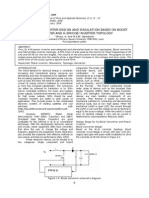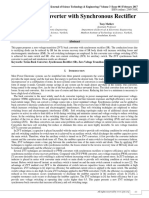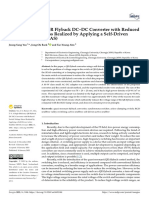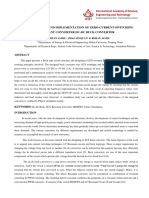Professional Documents
Culture Documents
Comparision of Voltage Stress Across The MOSFET Switch of A Flyback Converter With Various Snubbers
Original Title
Copyright
Available Formats
Share this document
Did you find this document useful?
Is this content inappropriate?
Report this DocumentCopyright:
Available Formats
Comparision of Voltage Stress Across The MOSFET Switch of A Flyback Converter With Various Snubbers
Copyright:
Available Formats
Volume 5, Issue 6, June – 2020 International Journal of Innovative Science and Research Technology
ISSN No:-2456-2165
Comparision of Voltage Stress Across the MOSFET
Switch of a Flyback Converter with Various Snubbers
Soumya A.N Nagashree R.S Geetha
Dept. of EEE Dept. of EEE Dept. of EEE
BMSCE BMSCE BMSCE
Bengaluru, India Bengaluru, India Bengaluru, India
Abstract:- A Flyback converter is a simple switch-mode The main focus in this paper is to compare voltage
power supply that can be used to generate a DC output stress on the converter switch using different snubber
from either an AC or DC input. The converter switch is circuits. This paper is organized as follows: Section I
the most critical part of any converter. The voltage consists of an introduction, Section Ⅱ explains the working
stress across the switch is a major issue as the high
voltage spikes occur due to interaction between its of Flyback converter, Section Ⅲ discusses about various
output capacitance and the leakage inductance of the types of snubber and its working, Section Ⅳ discusses the
transformer. These spikes can be reduced with various
simulation results of the Flyback converter with various
snubbers like conventional tertiary winding, Resistor
types of snubbers.
Capacitor and Diode(RCD) snubber, energy
regenerative snubber and an active clamp snubber. This
II. FLYBACK CONVERTER
paper aims to analyze and compare the voltage stress
across the MOSFET switch of Flyback converter with
Flyback converter is the most popular DC-DC
various snubber circuits.
converter topology for the applications involving 150W of
power or less as it is simple and cost effective. The basic
Keywords:- Active clamp snubber; Energy regenerative
topology of a Flyback circuit is shown in Fig. 1.
snubber; Flyback converter; RCD snubber; Tertiary
winding reset.
I. INTRODUCTION
Flyback converter is the simplest isolated DC-DC
converter topology widely used in low power applications
due to its cost effectiveness and electrical isolation
characteristics [1]. Its main power circuit comprises of a
MOSFET as a switch, a transformer, an output diode and Fig 1:- Conventional Flyback converter [2]
an output filter capacitor. The transformer winding
polarities of flyback converter are designed in such a way During switch on condition the energy is incorporated
that when the current passes through only one winding at a into the primary winding and due to the dot convention of
time [1]. the transformer as shown in Fig. 1, the energy from the
secondary winding does not get supplied to the load [3].
The application of transformer is an efficient method During this period, the output capacitor supplies the energy
to provide the electrical isolation between input and output to the load. During turn OFF condition, no current flows in
of a dc-dc converter [1]. A steady current builds-up in the transformer’s primary. Simultaneously, the
every cycle, within the magnetizing inductance of the transformer’s secondary voltage polarity changes.
transformer. This steady buildup of current results in Therefore, the energy is carried from the transformer to the
saturation of the transformer core [1]. Therefore, it needs to output. Thus, the operation of converter is determined by
be reset always for each pulse and this problem can be the dot-ends of the inductor [3]. The amount of output DC
solved by using a tertiary winding [1]. In Flyback voltage depends on the on-time of the switch during a
converters, switching voltage spikes appears across the switching period. For longer on time of the switch, larger
converter switches during its turn off time that can be output DC voltage is obtained. The transformer must be
reduced with the addition of snubber circuit [1]. A snubber reset to equalize the negative volt-seconds and positive
normally comprises of a capacitor that is greater than the volt-seconds. If this condition is not satisfied, then a large
output capacitance of the switch that helps to discharge the amount of energy will be stored in the transformer during a
output capacitor. A snubber circuit also serves to reduce switching cycle [3]. Due to this, the net accumulation of
turn-off switching losses [1]. energy causes the transformer saturation and also leads to
the short circuit of primary resulting in the failure of the
switch.
IJISRT20JUN1114 www.ijisrt.com 1567
Volume 5, Issue 6, June – 2020 International Journal of Innovative Science and Research Technology
ISSN No:-2456-2165
III. VARIOUS TYPES OF SNUBBERS A Flyback converter with energy regenerative snubber
is shown in Fig.3.
A. Tertiary winding method
The tertiary winding method is commonly used as
“reset” winding. This reset winding is tightly coupled to the
primary winding, to minimize the leakage between the
primary winding and the reset winding. This reset winding
can take-up all the ampere-turns from the primary winding
when the switch turns OFF [3].
B. Resistor Capacitor and Diode(RCD) snubber
Resistor Discharge Clamp(RCD) is one of the
simplest snubber circuit consisting of a resistor, a capacitor
and a diode. The problem of voltage stress can be solved
by the traditional method called passive RCD [4]. The
flyback converter with RCD snubber circuit is shown in Fig 3:- Flyback converter with energy regenerative snubber
Fig.2. [7].
(1)
(2)
Where,
: Input voltage;
: Magnetizing inductance;
: Leakage inductance;
: Current through the magnetizing inductance at time t;
: Current through the leakage inductance at time t.
D. Active clamp snubber
An active clamp snubber is the one that consists of an
active switch as shown in Fig. 4.
Fig 2:- Flyback converter with RCD snubber [5]
The flyback converter with the RCD snubber works as
follows: During turn off, the transformer leakage current has
two ways, the first one can be through the output
capacitance of the switch and one more through the snubber
circuit clamp capacitor (Csn).
In Flyback converter with RCD snubber, the rate of
rise of voltage across the switch is slower since the net
capacitance is larger resulting in lesser voltage across the
switch [5].
C. Energy regenerative snubber Fig. 4:- Flyback converter with active clamp snubber [8]
The most efficient snubbers are the ones that has an
ability to regenerate the energy without dissipating it [6]. An auxiliary switch and a clamp capacitor are used to
The converter works as follows: During the turn off reduce the voltage stress of active switch in the flyback
condition of switch Smain, the energy to the snubber converter [9]. This active switch enables the snubber to
capacitor Cclamp is supplied from the leakage inductance work with zero-voltage switching (ZVS). Application of
through the diode D1. Gradually, the current through D1 ZVS assures a vital reduction of switching losses due to the
and Cclamp decreased to zero. During the turn-on period of non-overlapping of voltage and current [10].
the switch, Cclamp discharges through the path that
includes a switch, the diode Dreg, and the auxiliary The flyback converter with active clamp snubber
winding. As the auxiliary winding(Lm)is linked to the main works as explained below: While the main switch S1 is
transformer thus the energy in the Cclamp is accumulated made to turn off, the energy of the transformer leakage
in the transformer [6]. This stored energy is discharged to inductance Lr is carried to the snubber capacitor Cclamp by
the output in addition to the energy that is usually stored in the body diode of S2[10When the current flows through its
the flyback transformer during turn off condition [6]. body diode, S2 can be turned on with ZVS [10]. In the
IJISRT20JUN1114 www.ijisrt.com 1568
Volume 5, Issue 6, June – 2020 International Journal of Innovative Science and Research Technology
ISSN No:-2456-2165
following switching cycle, the S1 is turned on and S2 is Fig. 6 shows the voltage stress across the switch with
turned off, then the current begins to flow through the body tertiary winding method.
diode of S1, thus enabling switch S2 to turn on with ZVS.
IV. SIMULATION RESULTS
Flyback converter with various snubbers are simulated
using LTspice tool. The voltage stress across the MOSFET
with different snubber circuits are compared and the results
are discussed as below.
The designed values of Flyback converter are shown in
Table 1:
Input voltage 24V
Output voltage 7V Fig 6:- Voltage stress across the switch with tertiary
Duty ratio 40% winding
Output power 10watt
It is observed that, with an input voltage of 24V, the
Efficiency ≥75% voltage stress across the switch is 480V.
Turns ratio 3.0
Switching frequency 40kHz RCD snubber
Primary winding inductance 90uH
Secondary winding inductance 10uH
Output Capacitance 200uF
Load 8 ohm
Table 1:- Designed Values of the Flyback Converter
Fig.5 to Fig.12 presents the voltage stress across
MOSFET of Flyback converter with tertiary winding, RCD
snubber, energy regenerative snubber and active clamp
snubber.
Tertiary winding method
Fig 7:- Flyback converter with RCD snubber
Fig. 8 shows the voltage stress across the switch with a
RCD snubber.
Fig 8:- Voltage stress across the switch with RCD snubber
Fig 5:- Flyback converter with tertiary winding
It is observed that, with an input voltage of 24V, the
voltage stress across the switch is 450V.
IJISRT20JUN1114 www.ijisrt.com 1569
Volume 5, Issue 6, June – 2020 International Journal of Innovative Science and Research Technology
ISSN No:-2456-2165
Energy regenerative snubber Fig. 12 shows the voltage stress across the switch with
a active clamp snubber
Fig 12:- Voltage stress across the switch with active clamp
snubber.
Fig 9:- Flyback converter with energy regenerative
snubber It is observed that, with the input voltage of 24V, the
voltage stress across the switch is 54V.
Fig. 10 shows the voltage stress across the switch with
a energy regenerative snubber. The input and output voltage for the Flyback
converter with all the snubbers are common as specified in
Table 1 and the same is shown in Fig.13.
Fig 10:- Voltage stress across the switch with energy
regenerative snubber.
It is observed that, with the input voltage of 24V, the Fig 13:- Input and output voltage of Flyback converter
voltage stress across the switch is 180V. with various snubber circuits.
Active clamp snubber It is observed that, with the input voltage of 24V, the
output voltage with all the snubbers is observed to be
constant at 7V.
The input voltage, output voltage and voltage stress
across the switch with all snubbers are summarized in
Table 2.
Table 2:- Comparision of Voltage Stress with All Types of
Fig 11:- Flyback converter with active clamp snubber
Snubbers
IJISRT20JUN1114 www.ijisrt.com 1570
Volume 5, Issue 6, June – 2020 International Journal of Innovative Science and Research Technology
ISSN No:-2456-2165
It is observed from Table 2 that the voltage stress [8]. S. M. Tadvin, S. R. B. Shah and M. R. T. Hossain.
across the switch of a Flyback converter with active clamp (2018) "A Brief Review of Snubber Circuits for
snubber is less when compared with other types of snubbers. Flyback Converter,"3rd International Conference for
Convergence in Technology , (pp.1-5).
V. CONCLUSION [9]. Bor-Ren Lin, Kevin Huang and David Wang. (2006)
"Analysis, design, and implementation of an active
In this work, the simulation results with different clamp forward converter with synchronous rectifier,"
snubber circuits namely Tertiary winding method, RCD in IEEE Transactions on Circuits and Systems vol. 53,
snubber, Energy regenerative snubber and Active clamp no. 6,( pp. 1310-1319).
snubber are discussed for a Flyback converter. [10]. Y. Liu, B. Huang, C. Lin, K. A. Kim and H. Chiu.
(2018) "Design and Implementation of a High Power
The voltage stress across the MOSFET switch of the Density Active-Clamped Flyback Converter,"
Flyback converter is compared with these different snubber International Power Electronics Conference ( pp.
circuits. It is observed from the simulation results that, 2092-2096).
active clamp snubber is found to be better compared with all
other snubbers circuits considered in this work as the
voltage stress across the MOSFET switch is found to be the
least.
ACKNOWLEDGEMENT
Authors are grateful to the management, BMS
Educational Trust, Principal and Vice-Principal, BMS
college of Engineering for their valuable support.
REFERENCES
[1]. Daniel. W. Hart, “Power Electronics”, The McGraw-
Hill Company, 3rd edition, 2010.
[2]. A. Boyar and E. Kabalci. (2018) "Comparison of a
Two-Phase Interleaved Boost Converter and Flyback
Converter," IEEE 18th International Power
Electronics and Motion Control Conference, (pp. 352-
356).
[3]. N. Coruh, S. Urgun and T. Erfidan. (2010) "Design
and implementation of flyback converters," 5th IEEE
Conference on Industrial Electronics and
Applications, (pp. 1189-1193).
[4]. H. Chung, S. Y. R. Hui and W. H. Wang. (1997) "An
isolated fully soft-switched flyback converter with
low voltage stress," PESC97. Record 28th Annual
IEEE Power Electronics Specialists Conference.
Formerly Power Conditioning Specialists Conference
1970-71. Power Processing and Electronic Specialists
Conference , (pp. 1417-1423 vol.2)
[5]. R. Kanthimathi and J. Kamala. (2015) "Analysis of
different flyback Converter topologies," International
Conference on Industrial Instrumentation and Control
, (pp. 1248-1252).
[6]. C. Liao, and K. Smedley. (2008) “Design of High
Efficiency Flyback converter with energy regenerative
snubber,” Applied Power Electronics Conference and
Exposition ,( pp.796-800).
[7]. A. Alganidi and G. Moschopoulos. (2018) "A
Comparative Study of Two Passive Regenerative
Snubbers for Flyback Converters," IEEE
International Symposium on Circuits and Systems ,
(pp. 1-4).
IJISRT20JUN1114 www.ijisrt.com 1571
You might also like
- Reference Guide To Useful Electronic Circuits And Circuit Design Techniques - Part 2From EverandReference Guide To Useful Electronic Circuits And Circuit Design Techniques - Part 2No ratings yet
- 135264ijsetr6989 1453Document8 pages135264ijsetr6989 1453wasabikikkomanNo ratings yet
- Snubber Circuits Suppress Voltage Transient Spikes in Multiple Output DC-DC Flyback Converter Power SuppliesDocument11 pagesSnubber Circuits Suppress Voltage Transient Spikes in Multiple Output DC-DC Flyback Converter Power SuppliesPlatin1976No ratings yet
- ZVS Boost Converter With A Flyback Snubber CircuitDocument8 pagesZVS Boost Converter With A Flyback Snubber Circuitmishranamit2211No ratings yet
- Speed Control of Separately Excited DC Motor Using Power Electronic ConverterDocument5 pagesSpeed Control of Separately Excited DC Motor Using Power Electronic ConverterIJIERT-International Journal of Innovations in Engineering Research and Technology100% (1)
- Design and Application For PV Generation System Using A Soft-Switching Boost Converter With SARCDocument13 pagesDesign and Application For PV Generation System Using A Soft-Switching Boost Converter With SARCIJERDNo ratings yet
- 53 Paper CONIELECOMP2010Document7 pages53 Paper CONIELECOMP2010Vinícius Vasconcelos Do RêgoNo ratings yet
- A New, Soft-Switched, High-Power-Factor Boost Converter With IgbtsDocument8 pagesA New, Soft-Switched, High-Power-Factor Boost Converter With IgbtsNandish AcharlNo ratings yet
- Igbt 1Document13 pagesIgbt 1Ştãÿfïã Päs PlůsNo ratings yet
- A Implementation of Single-Switch Nonisolated Transformerless Buck-Boost DC-DC ConverterDocument6 pagesA Implementation of Single-Switch Nonisolated Transformerless Buck-Boost DC-DC ConverterKPCYP COHODNo ratings yet
- Analysis of Different Flyback Converter TopologiesDocument5 pagesAnalysis of Different Flyback Converter TopologiesBastianHerreraBugueñoNo ratings yet
- Analysis and Design of a Single-Phase Tapped-Coupled-Inductor Boost DC–DC ConverterDocument11 pagesAnalysis and Design of a Single-Phase Tapped-Coupled-Inductor Boost DC–DC ConverterCristian-Valentin Radu0% (1)
- Full Bridge ConverterDocument10 pagesFull Bridge ConvertermuqeetmmaNo ratings yet
- Analysis of Buck Converter and Simulating It For Different Switching Frequencies and Different Power DevicesDocument6 pagesAnalysis of Buck Converter and Simulating It For Different Switching Frequencies and Different Power DevicesPrema Vinod PatilNo ratings yet
- Snubber CircuitsDocument5 pagesSnubber CircuitsberbouNo ratings yet
- The Design of Electric Car DC DC Converter Based On The Phase Shifted Full Bridge Zvs ControlDocument5 pagesThe Design of Electric Car DC DC Converter Based On The Phase Shifted Full Bridge Zvs ControlAniket ManjareNo ratings yet
- E1PWAX 2016 v16n4 1256 PDFDocument12 pagesE1PWAX 2016 v16n4 1256 PDFSunny ElNo ratings yet
- 5KVA Inverter Boost H-BridgeDocument8 pages5KVA Inverter Boost H-BridgeThèm Khát100% (1)
- Investigation and Analysis of Switching Performance of Boost ConverterDocument6 pagesInvestigation and Analysis of Switching Performance of Boost ConvertererpublicationNo ratings yet
- Research Article: On The Development of High Power DC-DC Step-Down Converter With Energy Recovery SnubberDocument10 pagesResearch Article: On The Development of High Power DC-DC Step-Down Converter With Energy Recovery SnubberefremofeNo ratings yet
- 19MO504-IE 2 MarksDocument40 pages19MO504-IE 2 MarksSaranya. M SNSNo ratings yet
- Family of Soft-Switching PWMDocument7 pagesFamily of Soft-Switching PWMMohan KrishnaNo ratings yet
- Transformer-Less Voltage Stabilizer Controlled by Proportional-Plus-Integral (PI) ControllerDocument10 pagesTransformer-Less Voltage Stabilizer Controlled by Proportional-Plus-Integral (PI) ControllerK. RAJA SEKARNo ratings yet
- Resonant Converter Topologies: Application NoteDocument5 pagesResonant Converter Topologies: Application Notesatyam swarup dubeyNo ratings yet
- Comparison and Simulation of Full Bridge and LCL-T Buck DC-DC Converter SystemsDocument5 pagesComparison and Simulation of Full Bridge and LCL-T Buck DC-DC Converter SystemsKrishnaveni Subramani SNo ratings yet
- Enhanced Switching Characteristics of DC-DC Boost Converter SystemsDocument7 pagesEnhanced Switching Characteristics of DC-DC Boost Converter Systemsmhd ali mustofah nstNo ratings yet
- Design and Simulation of Boost Converters Suitable For Photo Voltaic ApplicationsDocument9 pagesDesign and Simulation of Boost Converters Suitable For Photo Voltaic ApplicationsMadhu SudhanNo ratings yet
- An222a DDocument16 pagesAn222a DMario Plinio CrivelliNo ratings yet
- Selection of High Efficient Passive Soft Switching Regenerative Snubber For DC-DC Boost ConverterDocument5 pagesSelection of High Efficient Passive Soft Switching Regenerative Snubber For DC-DC Boost ConverterYuvrajsinh ChauhanNo ratings yet
- An Analysis of Buck Converter Efficiency in PWM/PFM Mode With SimulinkDocument6 pagesAn Analysis of Buck Converter Efficiency in PWM/PFM Mode With SimulinkAli RazaNo ratings yet
- Implementation of Analysis and Design of Forward Converter With Energy Regenerative Snubber PDFDocument8 pagesImplementation of Analysis and Design of Forward Converter With Energy Regenerative Snubber PDFKamal KamalgNo ratings yet
- Fly-Back Mode 150wDocument17 pagesFly-Back Mode 150wanon_4880132No ratings yet
- A New Soft-Switching Technique For Buck, BoostDocument8 pagesA New Soft-Switching Technique For Buck, BoostVisu TamilNo ratings yet
- A DC DC Boost Converter With Voltage MulDocument5 pagesA DC DC Boost Converter With Voltage Mulfausto fabriziNo ratings yet
- ZVT Buck Converter With Synchronous RectifierDocument10 pagesZVT Buck Converter With Synchronous RectifierIJSTENo ratings yet
- AN848 DynamicDocument9 pagesAN848 DynamicAnonymous QakmLc3kTINo ratings yet
- A High-Efficiency QR Flyback DC-DC Converter WithDocument21 pagesA High-Efficiency QR Flyback DC-DC Converter WithRakesh SandarativjuNo ratings yet
- Current Limiting TransformerDocument5 pagesCurrent Limiting TransformerJournalNX - a Multidisciplinary Peer Reviewed JournalNo ratings yet
- Generating Switching Impulse Voltage by Adjusting ParametersDocument8 pagesGenerating Switching Impulse Voltage by Adjusting ParameterssanketNo ratings yet
- Extended Range Soft Switched, Transformer-Coupled Multiport Resonant Switch Converter (ZVS) For Fuel Cell ApplicationDocument8 pagesExtended Range Soft Switched, Transformer-Coupled Multiport Resonant Switch Converter (ZVS) For Fuel Cell ApplicationInternational Journal of Application or Innovation in Engineering & ManagementNo ratings yet
- ClampDocument8 pagesClampGaetano GaetanoNo ratings yet
- EEE 54 DP2 DocumentationDocument5 pagesEEE 54 DP2 DocumentationDarl John MendozaNo ratings yet
- Isolated Bidirectional Full-Bridge DCDC Converter With A Flyback SnubberDocument8 pagesIsolated Bidirectional Full-Bridge DCDC Converter With A Flyback SnubberHsekum RamukNo ratings yet
- Switched Inductor Based Quadratic ConverterDocument6 pagesSwitched Inductor Based Quadratic ConverterInternational Journal of Innovative Science and Research TechnologyNo ratings yet
- Analysis and Construction of Push Pull Converter - Noor Rulmuna Bt. Mohd Sarmin - TK7872.C8.N66 2006Document27 pagesAnalysis and Construction of Push Pull Converter - Noor Rulmuna Bt. Mohd Sarmin - TK7872.C8.N66 2006Rizwan FaizNo ratings yet
- Analysis, Design and Implementation of Zero-Current-Switching Resonant Converter DC-DC Buck ConverterDocument12 pagesAnalysis, Design and Implementation of Zero-Current-Switching Resonant Converter DC-DC Buck Converterdaber_huny20No ratings yet
- Topic 3 LynchDocument26 pagesTopic 3 Lynchsunil251No ratings yet
- Sana’a University Power SupplyDocument16 pagesSana’a University Power SupplytahaNo ratings yet
- Speedam 2008 FINAL Mag IntDocument9 pagesSpeedam 2008 FINAL Mag IntbiswajitntpcNo ratings yet
- EEE - IJEEE - Analysis, Design and - Irfan Jamil - China-PakistanDocument12 pagesEEE - IJEEE - Analysis, Design and - Irfan Jamil - China-Pakistaniaset123No ratings yet
- 3143 PDFDocument5 pages3143 PDFSalas gamerNo ratings yet
- A High-Gain Nanosecond Pulse Generator Based On Inductor Energy Storage andDocument4 pagesA High-Gain Nanosecond Pulse Generator Based On Inductor Energy Storage andAhmadreza GhanaatianNo ratings yet
- 1.1 Introduction To Buck ConverterDocument44 pages1.1 Introduction To Buck Converterapi-19810277No ratings yet
- Low Power Ring Oscillator at 180nm CMOS Technology: Aman Shivhare M. K. GuptaDocument4 pagesLow Power Ring Oscillator at 180nm CMOS Technology: Aman Shivhare M. K. GuptaRam MNo ratings yet
- Single-Inductor Multiple-Output Switching Converters With Time-Multiplexing Control in Discontinuous Conduction ModeDocument12 pagesSingle-Inductor Multiple-Output Switching Converters With Time-Multiplexing Control in Discontinuous Conduction ModeZhongpeng LiangNo ratings yet
- Current-Source Resonant Converter in Power Factor CorrectionDocument7 pagesCurrent-Source Resonant Converter in Power Factor CorrectionJie99No ratings yet
- Design Fabrication and Performance Analysis of Solar InverterDocument5 pagesDesign Fabrication and Performance Analysis of Solar InverterSyed ZadaaNo ratings yet
- Modeling and Simulation of Single Phase CycloconvertorDocument3 pagesModeling and Simulation of Single Phase CycloconvertorijeteeditorNo ratings yet
- Automatic Power Factor ControllerDocument4 pagesAutomatic Power Factor ControllerInternational Journal of Innovative Science and Research TechnologyNo ratings yet
- Intelligent Engines: Revolutionizing Manufacturing and Supply Chains with AIDocument14 pagesIntelligent Engines: Revolutionizing Manufacturing and Supply Chains with AIInternational Journal of Innovative Science and Research TechnologyNo ratings yet
- Navigating Digitalization: AHP Insights for SMEs' Strategic TransformationDocument11 pagesNavigating Digitalization: AHP Insights for SMEs' Strategic TransformationInternational Journal of Innovative Science and Research TechnologyNo ratings yet
- A Review: Pink Eye Outbreak in IndiaDocument3 pagesA Review: Pink Eye Outbreak in IndiaInternational Journal of Innovative Science and Research TechnologyNo ratings yet
- Teachers' Perceptions about Distributed Leadership Practices in South Asia: A Case Study on Academic Activities in Government Colleges of BangladeshDocument7 pagesTeachers' Perceptions about Distributed Leadership Practices in South Asia: A Case Study on Academic Activities in Government Colleges of BangladeshInternational Journal of Innovative Science and Research TechnologyNo ratings yet
- Securing Document Exchange with Blockchain Technology: A New Paradigm for Information SharingDocument4 pagesSecuring Document Exchange with Blockchain Technology: A New Paradigm for Information SharingInternational Journal of Innovative Science and Research TechnologyNo ratings yet
- Mobile Distractions among Adolescents: Impact on Learning in the Aftermath of COVID-19 in IndiaDocument2 pagesMobile Distractions among Adolescents: Impact on Learning in the Aftermath of COVID-19 in IndiaInternational Journal of Innovative Science and Research TechnologyNo ratings yet
- Studying the Situation and Proposing Some Basic Solutions to Improve Psychological Harmony Between Managerial Staff and Students of Medical Universities in Hanoi AreaDocument5 pagesStudying the Situation and Proposing Some Basic Solutions to Improve Psychological Harmony Between Managerial Staff and Students of Medical Universities in Hanoi AreaInternational Journal of Innovative Science and Research TechnologyNo ratings yet
- Review of Biomechanics in Footwear Design and Development: An Exploration of Key Concepts and InnovationsDocument5 pagesReview of Biomechanics in Footwear Design and Development: An Exploration of Key Concepts and InnovationsInternational Journal of Innovative Science and Research TechnologyNo ratings yet
- Perceived Impact of Active Pedagogy in Medical Students' Learning at the Faculty of Medicine and Pharmacy of CasablancaDocument5 pagesPerceived Impact of Active Pedagogy in Medical Students' Learning at the Faculty of Medicine and Pharmacy of CasablancaInternational Journal of Innovative Science and Research TechnologyNo ratings yet
- Formation of New Technology in Automated Highway System in Peripheral HighwayDocument6 pagesFormation of New Technology in Automated Highway System in Peripheral HighwayInternational Journal of Innovative Science and Research TechnologyNo ratings yet
- Natural Peel-Off Mask Formulation and EvaluationDocument6 pagesNatural Peel-Off Mask Formulation and EvaluationInternational Journal of Innovative Science and Research TechnologyNo ratings yet
- Drug Dosage Control System Using Reinforcement LearningDocument8 pagesDrug Dosage Control System Using Reinforcement LearningInternational Journal of Innovative Science and Research TechnologyNo ratings yet
- The Effect of Time Variables as Predictors of Senior Secondary School Students' Mathematical Performance Department of Mathematics Education Freetown PolytechnicDocument7 pagesThe Effect of Time Variables as Predictors of Senior Secondary School Students' Mathematical Performance Department of Mathematics Education Freetown PolytechnicInternational Journal of Innovative Science and Research TechnologyNo ratings yet
- Enhancing the Strength of Concrete by Using Human Hairs as a FiberDocument3 pagesEnhancing the Strength of Concrete by Using Human Hairs as a FiberInternational Journal of Innovative Science and Research TechnologyNo ratings yet
- Supply Chain 5.0: A Comprehensive Literature Review on Implications, Applications and ChallengesDocument11 pagesSupply Chain 5.0: A Comprehensive Literature Review on Implications, Applications and ChallengesInternational Journal of Innovative Science and Research TechnologyNo ratings yet
- Advancing Opthalmic Diagnostics: U-Net for Retinal Blood Vessel SegmentationDocument8 pagesAdvancing Opthalmic Diagnostics: U-Net for Retinal Blood Vessel SegmentationInternational Journal of Innovative Science and Research TechnologyNo ratings yet
- The Making of Self-Disposing Contactless Motion-Activated Trash Bin Using Ultrasonic SensorsDocument7 pagesThe Making of Self-Disposing Contactless Motion-Activated Trash Bin Using Ultrasonic SensorsInternational Journal of Innovative Science and Research TechnologyNo ratings yet
- Placement Application for Department of Commerce with Computer Applications (Navigator)Document7 pagesPlacement Application for Department of Commerce with Computer Applications (Navigator)International Journal of Innovative Science and Research TechnologyNo ratings yet
- REDLINE– An Application on Blood ManagementDocument5 pagesREDLINE– An Application on Blood ManagementInternational Journal of Innovative Science and Research TechnologyNo ratings yet
- Beyond Shelters: A Gendered Approach to Disaster Preparedness and Resilience in Urban CentersDocument6 pagesBeyond Shelters: A Gendered Approach to Disaster Preparedness and Resilience in Urban CentersInternational Journal of Innovative Science and Research TechnologyNo ratings yet
- Exploring the Clinical Characteristics, Chromosomal Analysis, and Emotional and Social Considerations in Parents of Children with Down SyndromeDocument8 pagesExploring the Clinical Characteristics, Chromosomal Analysis, and Emotional and Social Considerations in Parents of Children with Down SyndromeInternational Journal of Innovative Science and Research TechnologyNo ratings yet
- Handling Disruptive Behaviors of Students in San Jose National High SchoolDocument5 pagesHandling Disruptive Behaviors of Students in San Jose National High SchoolInternational Journal of Innovative Science and Research TechnologyNo ratings yet
- Safety, Analgesic, and Anti-Inflammatory Effects of Aqueous and Methanolic Leaf Extracts of Hypericum revolutum subsp. kenienseDocument11 pagesSafety, Analgesic, and Anti-Inflammatory Effects of Aqueous and Methanolic Leaf Extracts of Hypericum revolutum subsp. kenienseInternational Journal of Innovative Science and Research TechnologyNo ratings yet
- A Curious Case of QuadriplegiaDocument4 pagesA Curious Case of QuadriplegiaInternational Journal of Innovative Science and Research TechnologyNo ratings yet
- A Knowledg Graph Model for e-GovernmentDocument5 pagesA Knowledg Graph Model for e-GovernmentInternational Journal of Innovative Science and Research TechnologyNo ratings yet
- Analysis of Financial Ratios that Relate to Market Value of Listed Companies that have Announced the Results of their Sustainable Stock Assessment, SET ESG Ratings 2023Document10 pagesAnalysis of Financial Ratios that Relate to Market Value of Listed Companies that have Announced the Results of their Sustainable Stock Assessment, SET ESG Ratings 2023International Journal of Innovative Science and Research TechnologyNo ratings yet
- Pdf to Voice by Using Deep LearningDocument5 pagesPdf to Voice by Using Deep LearningInternational Journal of Innovative Science and Research TechnologyNo ratings yet
- Adoption of International Public Sector Accounting Standards and Quality of Financial Reporting in National Government Agricultural Sector Entities, KenyaDocument12 pagesAdoption of International Public Sector Accounting Standards and Quality of Financial Reporting in National Government Agricultural Sector Entities, KenyaInternational Journal of Innovative Science and Research TechnologyNo ratings yet
- Fruit of the Pomegranate (Punica granatum) Plant: Nutrients, Phytochemical Composition and Antioxidant Activity of Fresh and Dried FruitsDocument6 pagesFruit of the Pomegranate (Punica granatum) Plant: Nutrients, Phytochemical Composition and Antioxidant Activity of Fresh and Dried FruitsInternational Journal of Innovative Science and Research TechnologyNo ratings yet
- Interest RatesDocument207 pagesInterest RatesBenjamin RogersNo ratings yet
- Electric Vehicle BatteryDocument15 pagesElectric Vehicle BatteryTotal Acess100% (1)
- Computed Tomography (CT) - BodyDocument7 pagesComputed Tomography (CT) - Bodyfery oktoraNo ratings yet
- (Distracted Subjects) CHAPTER 2. Reading The Language of Distraction - Hamlet, Macbeth, King LearDocument23 pages(Distracted Subjects) CHAPTER 2. Reading The Language of Distraction - Hamlet, Macbeth, King LearLCAP ConsultingNo ratings yet
- Weld Procedure Specification (WPS) : Joint Design Welding SequenceDocument1 pageWeld Procedure Specification (WPS) : Joint Design Welding SequenceRicardo SoaresNo ratings yet
- Maret 2021Document36 pagesMaret 2021Muhammad Pahlan PiruzziNo ratings yet
- Penyakit Palpebra Dan AdneksaDocument39 pagesPenyakit Palpebra Dan AdneksaayucicuNo ratings yet
- Cost Estimation of SlaughterhouseDocument25 pagesCost Estimation of Slaughterhousemohamed faahiyeNo ratings yet
- Barangay Ordinance Vaw 2018Document7 pagesBarangay Ordinance Vaw 2018barangay artacho1964 bautista100% (3)
- Microeconomics 5th Edition Hubbard Solutions Manual 1Document23 pagesMicroeconomics 5th Edition Hubbard Solutions Manual 1christina100% (48)
- CH 23 PDFDocument42 pagesCH 23 PDFkrishnaNo ratings yet
- Chapter 3 NotesDocument10 pagesChapter 3 Notesmjamie12345No ratings yet
- Physical Science Summative Exam. First QuarterDocument5 pagesPhysical Science Summative Exam. First QuarterIsagani WagisNo ratings yet
- DepEd Region I Summative Test in Cookery 9Document2 pagesDepEd Region I Summative Test in Cookery 9Jessel Mejia OnzaNo ratings yet
- Gimnazjum Exam Practice GuideDocument74 pagesGimnazjum Exam Practice GuideVaserd MoasleNo ratings yet
- Fuel System D28Document4 pagesFuel System D28Ian MuhammadNo ratings yet
- Community Medicine DissertationDocument7 pagesCommunity Medicine DissertationCollegePaperGhostWriterSterlingHeights100% (1)
- ECG ProjectDocument34 pagesECG Projectsamsai888No ratings yet
- Environmental Pollution and DegradationDocument2 pagesEnvironmental Pollution and DegradationCharLene MaRieNo ratings yet
- Three Little PigsDocument9 pagesThree Little PigsrNo ratings yet
- Glulam Wood BeamsDocument37 pagesGlulam Wood Beamsu16sr6No ratings yet
- Brian Cody Mcgonegal ResumeDocument2 pagesBrian Cody Mcgonegal Resumeapi-348833348No ratings yet
- 16 Point Msds Format As Per ISO-DIS11014 PDFDocument8 pages16 Point Msds Format As Per ISO-DIS11014 PDFAntony JebarajNo ratings yet
- WASA Wastewater and Potable Water Design Requirements PDFDocument233 pagesWASA Wastewater and Potable Water Design Requirements PDFYassin AlkadyNo ratings yet
- LLL'DSWD: Administrative Order No. Series 2017Document18 pagesLLL'DSWD: Administrative Order No. Series 2017SGTNo ratings yet
- In-Vitro Anti-Lipase and Antioxidant Activity of Polyherbal AyurvedicDocument9 pagesIn-Vitro Anti-Lipase and Antioxidant Activity of Polyherbal AyurvedicErvi DyahNo ratings yet
- TLC Analysis of Siling Labuyo Extract ComponentsDocument3 pagesTLC Analysis of Siling Labuyo Extract ComponentsJan Eric Balete0% (1)
- Design of Low Cost, Energy Efficient, IotDocument6 pagesDesign of Low Cost, Energy Efficient, IotRulemaker Studios OfficialNo ratings yet
- Chronic Pain GuidelinesDocument56 pagesChronic Pain GuidelinesOporadhBiggan100% (1)
- Paper Pet ProjectDocument27 pagesPaper Pet Projectapi-406104878No ratings yet























































































































